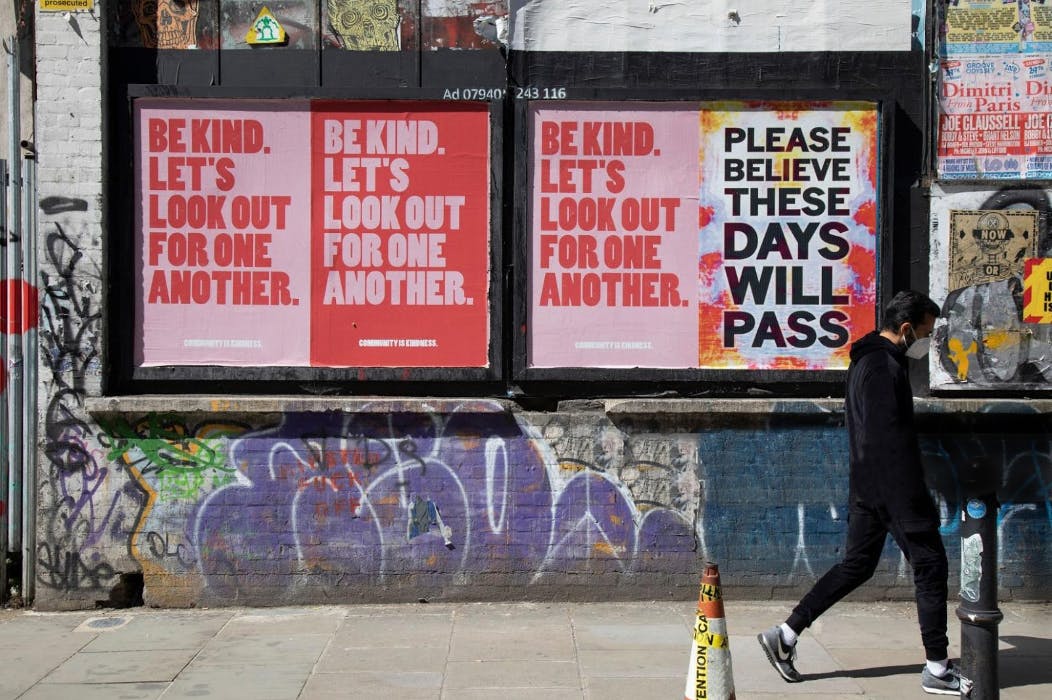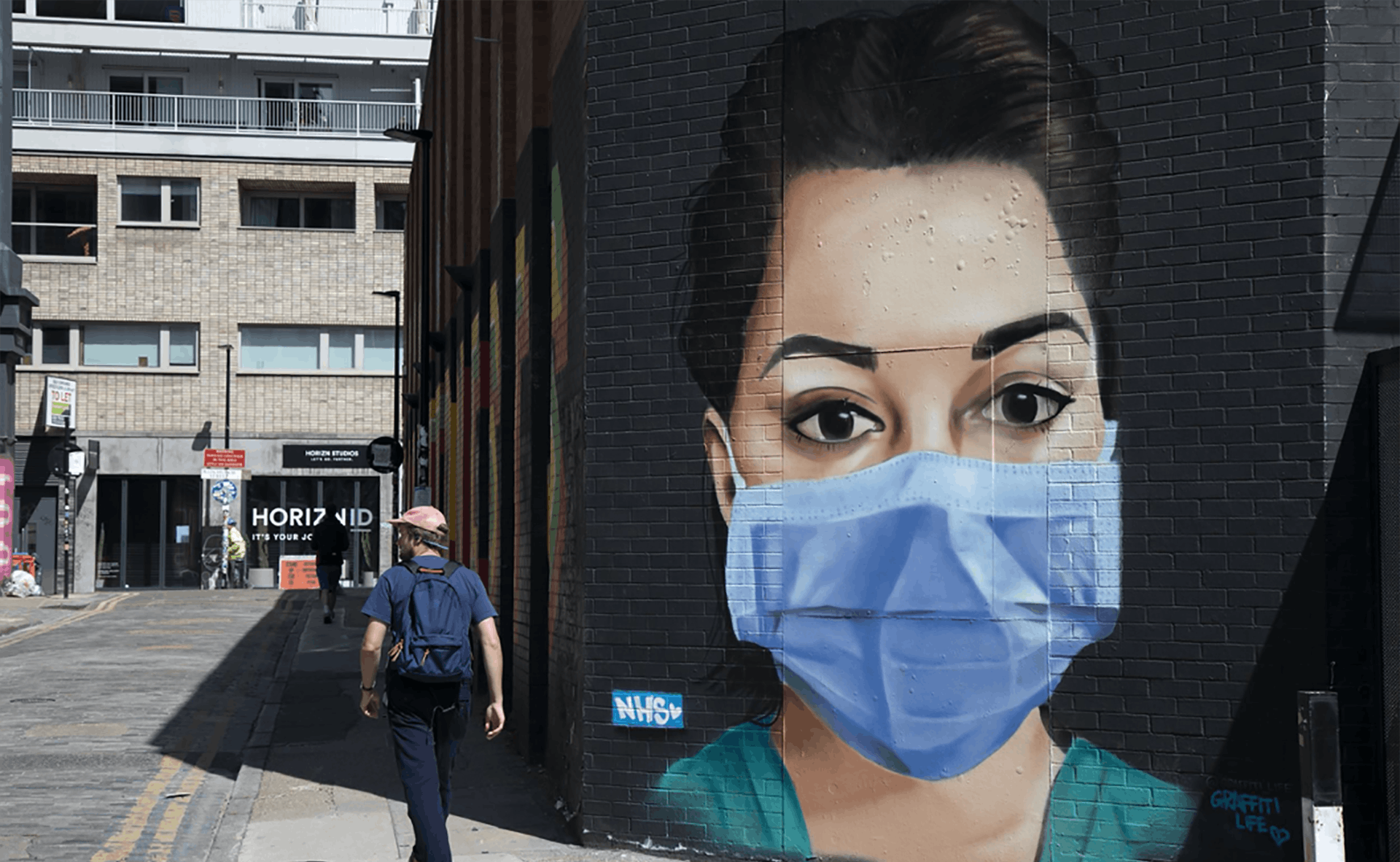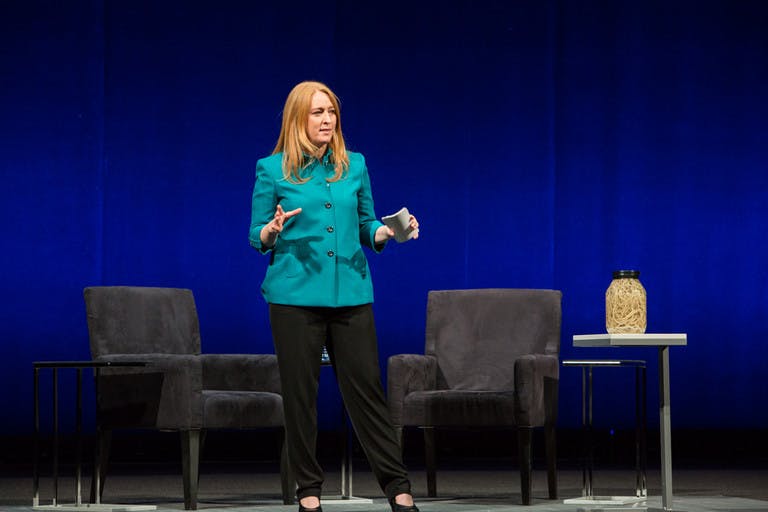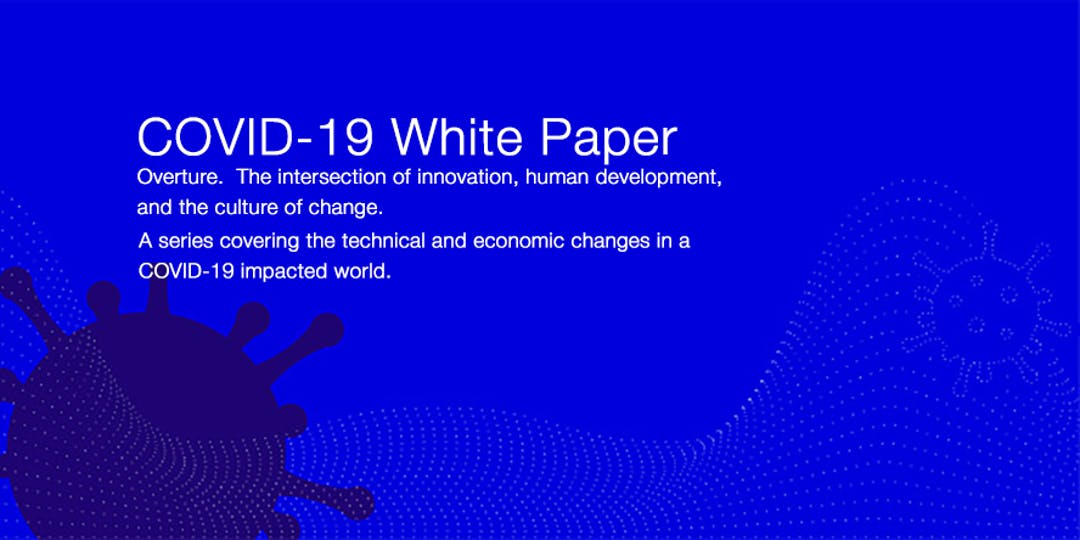
Click here to download a PDF of this white paper.
Contact tracing is an essential component of managing the global COVID-19 pandemic. As governments begin to feel pressure to reopen their economies, the need to discover who has been infected with COVID-19 becomes more pressing. Until a vaccine is developed and whole populations can be tested safely, contact tracing remains the most accessible tool for gathering this information.
Government and health officials around the world are pursuing a path that supercharges the accuracy and reach of contact tracing through apps that use cell-phone location data and Bluetooth to track people’s daily contacts.
Many countries have already utilized this technology, including China, Singapore, South Korea, Israel, and the United Kingdom. The United States has not implemented a national technological contact-tracing system, but individual states are beginning to develop their own apps. Google and Apple are also joining forces for the first time to launch Bluetooth-enabled contact tracing between Android and iOS operating systems.
These developments have led to a number of concerns including the question of centralized versus decentralized contact-tracing systems, the question of whether to reopen the economy and concerns about the political and ethical implications of this type of mass-data gathering.
As it stands at present, contact-tracing apps have tremendous potential for their use in fighting the COVID-19 pandemic, but they face barriers to capitalizing on this potential. These barriers include difficulty in unifying different systems or systems used by different countries, difficulties in ensuring participation, and ethical concerns with data privacy.
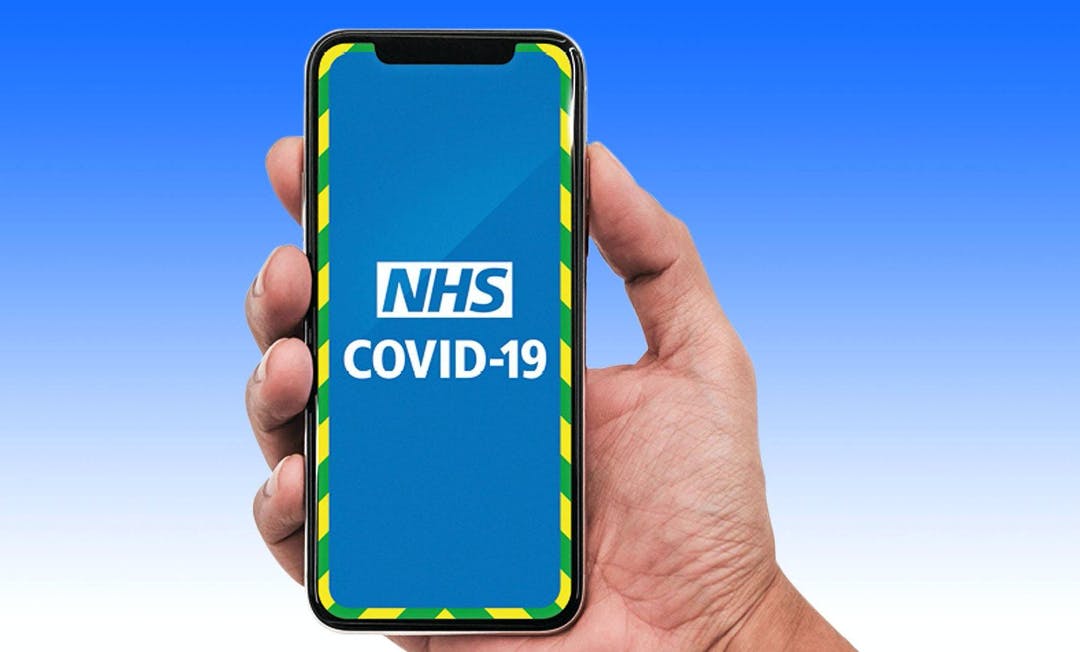
Overview of Contact Tracing
As the global COVID-19 pandemic begins to show signs of slowing, pressure is mounting to reopen economies around the world. However, until a vaccine is successfully developed and entire populations can be tested for the virus, reopening the economy without knowing who has or has not been infected is liable to cause a massive spike in transmission, akin to the deadly second wave of the 1918 Spanish flu, which killed more people than the initial outbreak: Source
Yet until a vaccine is developed or testing of entire populations is rolled out, doing so without knowing exactly who is or is not infected is sure to cause a spike in transmissions. Contact tracing is a traditional epidemiological technique that has been employed by humans in the fight against pandemic diseases as far back as the tenth century, well before viruses or bacteria were recognized as agents of communicable diseases: Source. The general process of contact tracing consists of three key steps:
● Contact identification: After the infection has been confirmed, contacts must be identified by gathering information from the patient about their activities and those of the people around them. Traditionally, this is done through interviews. However, this information can also be collected via technology.
● Contact listing: Contacts confirmed through patient information must be listed and contacted with information about their contact status, what this means, and actions to follow up and prevent the disease from spreading further.
● Contact follow-up: Regular follow-up with contacts to monitor symptoms and look for signs of infection: Source
Traditional contact-tracing methods include activities like interviews, phone calls, and home visits: Source. Today, the procedures of contact tracing can be made much less labor and time-intensive through technology, specifically via the tracing of cell phone location data.
Many countries have already introduced technology-driven contact-tracing systems. These countries include China, Singapore, South Korea, Israel, and the United Kingdom: Source. In the United States, Apple and Google have partnered on an initiative to create the technological infrastructure for these apps to operate via Bluetooth across Android and iOS: Source.
However, these contact-tracing apps have given rise to a lot of dialogues and disagreements about the best way to proceed. Some of the considerations include the use of centralized versus decentralized contact-tracing systems, the feasibility of reopening the economy given an implemented contact-tracing system, political and business issues, and issues of privacy.
Centralized versus Decentralized Systems
Both centralized and decentralized systems for contact tracing utilize Bluetooth beacons to note when users are close to each other so that if later on, somebody reports that they have tested positive, an alert can be sent to users who have recently been in close contact and may have been infected: Source. The difference is in how these data points are managed after being logged.
In centralized systems, the data processed by the app is all channeled and uploaded into a centrally run database, generally controlled by a government body or local health service. Matches are made in this database, and users are alerted when they have contacted somebody who is infected. As of late April, 70% of COVID-19 contact-tracing apps worldwide have used the centralized model, but this is likely to change: Source.
In decentralized systems, the data processed by the app is maintained on the user’s device, and the match is made here. This system only involves the uploading of an anonymous ID to a centralized database, which can then be downloaded to the user’s phone for contact tracing to happen there rather than in the centralized database.
Both systems have been used for contact tracing so far, and each has pros and cons, which are outlined in Table 1. It is unclear at this stage which is the better system. Some countries, like Germany and Poland, have even switched from a centralized to a decentralized system in response to concerns about privacy: Source.
How they work!

Table 1: Pros and cons of centralized and decentralized contact-tracing systems
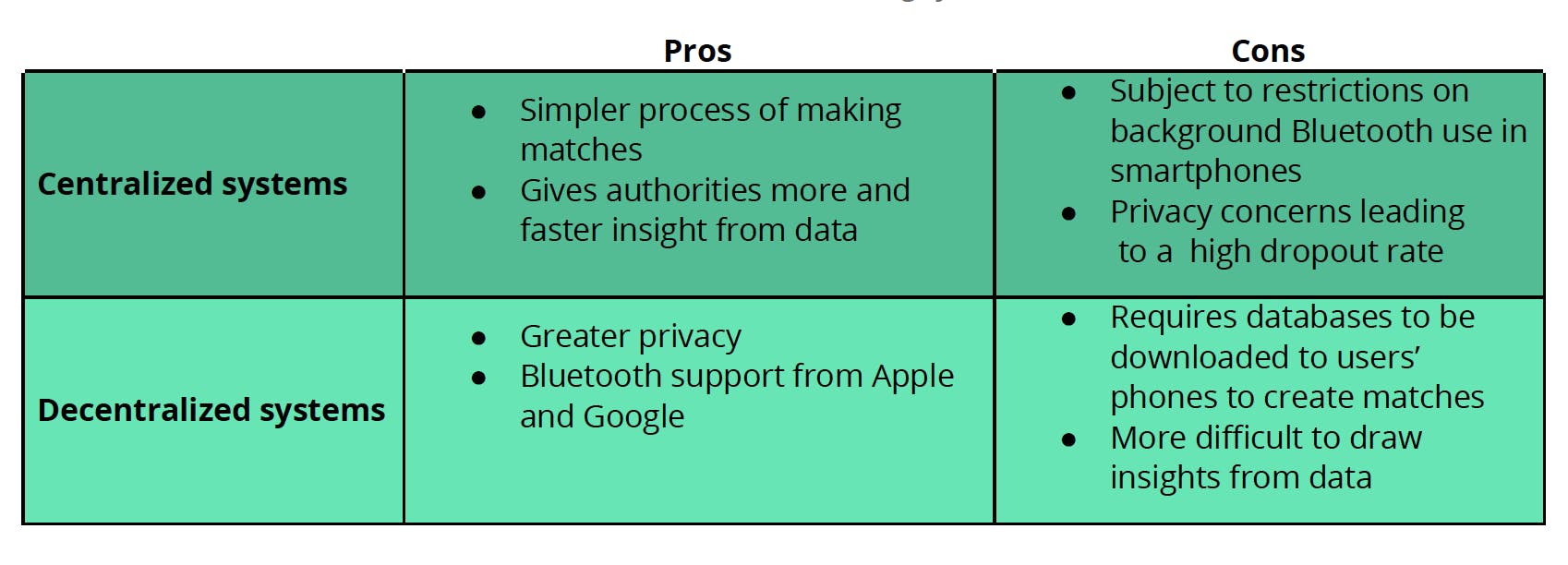
One vitally important difference between these two systems, given the number of people who use Apple and Android technology, is support from Apple and Google as corporations. Contact-tracing apps require Bluetooth to be running continuously, even while the phone is locked. Apple and Google have stated that this will only be made possible on decentralized systems. This means that for a centralized app to work, users’ phones would have to be unlocked at all times: Source. While it may be possible to work around this, it will prove difficult without the support of tech giants like Apple and Google.
Despite this obvious incentive towards decentralized systems, the debate about these two models continues. In Europe, the Pan-European Privacy-Preserving Proximity Tracing (PEPP-PT) is working to build a centralized contact-tracing system in direct competition with Decentralized Privacy-Preserving Proximity Tracing (DP3T), another European tech initiative that is working on a decentralized system: Source. In the United States, some states like Utah and Indiana are already abandoning the Apple Google model of contact tracing in favor of developing their own centralized systems: Source; Source.
The current difficulty in reaching a universal consensus on the use of centralized versus decentralized systems presents a major barrier towards effective contact tracing because these two systems are not compatible: Source. Countries like the United Kingdom are attempting to bypass this barrier while still utilizing a centralized system, but this introduces further compatibility issues between apps from different countries: Source. Continuing to operate two systems leads may thus lead to smaller, disconnected pools of data, which are less reliable for making major decisions like whether to reopen world economies. Discrete pools of data also complicate the issue of world travel – it is more difficult for countries to ensure safety in air travel when contact-tracing data is limited to individual countries rather than considered as an international network.
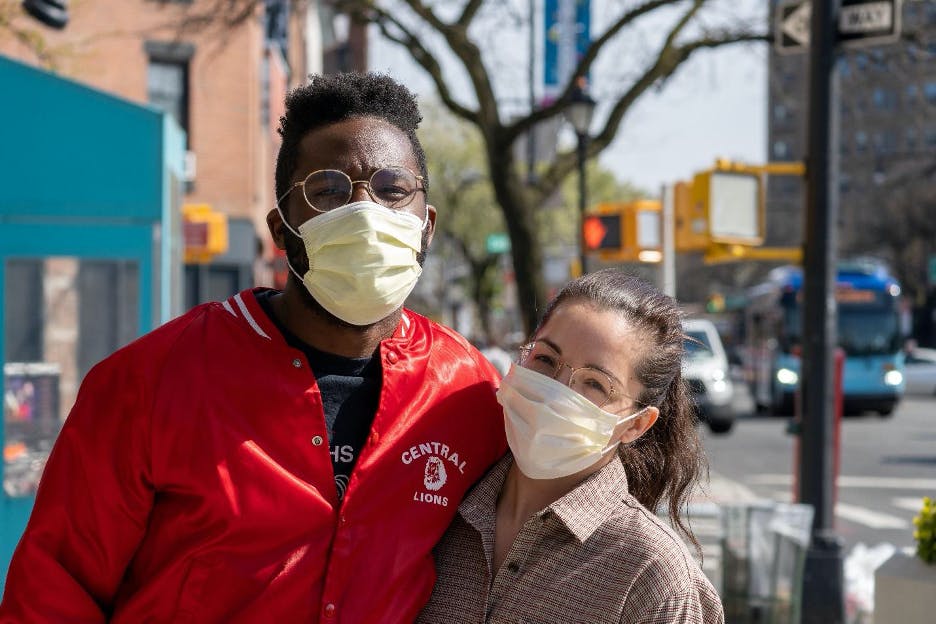
Reopening the Economy with Contact Tracing
The speed with which tech companies have developed contact-tracing systems begs the question of whether contact tracing will provide the necessary bridge to allow economies to safely reopen before we have developed a vaccine.
Contact tracing will be an essential part of strategies to reopen the economy, but many argue that technological contact-tracing solutions are not enough. These apps rely on users installing the app and consenting to data collection, which works in principle, but in practice, it is difficult to enforce compliance. For example, in Singapore, only an estimated 17% of the population installed their Trace Together contact-tracing app when it was first launched: Source. In the United States, an additional concern with compliance is undocumented immigrants, who may not be willing to use data-collecting apps for fear of deportation: Source.
While opinions do vary, the general consensus among experts is that contact tracing is just one step that needs to be taken before the economy can successfully reopen: Source. Additional necessary steps include widespread testing and sufficient hospital space in the event of another outbreak. Because the United States does not have a universal healthcare system, these benchmarks are being evaluated at the state level by governors.
However, this presents another barrier to reopening. COVID-19 is a global issue that has proven far more difficult to solve due to a lack of a unified containment effort. This, along with incompatibility between centralized and decentralized systems of contact tracing, makes it apparent that current technological contact-tracing systems alone are not enough to serve as a bridge to reopen the economy, but will serve a role in a broader strategy of containment, testing, and contact tracing. Even within contact-tracing, apps represent just one method to be used alongside traditional methods like phone interviews: Source.
Further Drivers for Conversation about Contact Tracing
Political and business interests
Data can be a powerful tool for governmental and political decisions. One of the motivators for using a centralized system is that it gives governments access to more data. While this helps health agencies make better decisions in response to the pandemic, it also sets a political precedent of allowing corrupt governments or political leaders to access whichever data they choose as for any reason they choose, good or bad.
As it stands, governments may be forced to choose decentralized systems in order to reap the benefits of partnering with Apple and Google (who command 24.79% and 74.13% of the mobile operating systems market share: Source): Source. Apple and Google’s choice of a decentralized contact-tracing system was likely one that was guided by political inputs and social goodwill rather than business interests and engineering.
Privacy
The discussion around centralized versus decentralized contact-tracing systems is ultimately one of privacy versus efficiency: Source. Contact-tracing apps deal with two very sensitive forms of data: location and health status, and how to gather and handle this data presents a major ethical issue. Continuous, non-anonymous collection of this data is effectively a form of government surveillance. Even anonymized data is not completely safe from privacy considerations. Research has demonstrated that in many cases it is possible to re-identify individuals even from incomplete sets of anonymized, aggregated data: Source. These privacy considerations may also lead to less compliance with mandates to use these apps, reducing their utility in observing trends, and drawing conclusions.
Conclusion
As it stands now, technological contact tracing alone is not a sufficient justification to reopen economies but should be used in conjunction with other containment strategies (comprehensive testing, preparing hospitals for surges, continued social distancing) to slow the spread of the virus. Even when contact-tracing apps become more powerful and unified, they should still represent just one part of a broader contact-tracing strategy.
The current state of COVID-19 contact-tracing apps suggests that we are several steps away from a truly comprehensive technological system for tracking COVID-19 infection, particularly when human complex migration and travel patterns are considered. Challenges with compatibility and privacy are currently keeping this technology from being utilized to its fullest potential. However, development is still well underway on these systems, and successes from major tech giants like Apple and Google may lead to a more unified contact-tracing effort between countries as those corporations continue to develop decentralized and privacy-friendly systems for contact tracing.
While these technologies are in the early and experimental phases, they are a strong step in the right direction. Some of the greatest changes in society are driven by innovation and technology, and it is critical to find the balance between innovation for innovation’s sake and allowing technology to play a greater role in helping us create healthier and more connected lives for ourselves and our families.
